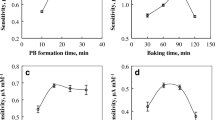Abstract
An amperometric biosensor has been developed for highly efficient and sensitive detection of catechol using Prussian blue (PB)-coated nickel oxide (NiO) nanoparticles (NPs) as a matrix for the immobilization of tyrosinase enzyme. The NiO NPs were synthesized by sol-gel method using sodium dodecyl sulphate as anionic surfactant and the surface of the synthesized NiO NPs was modified with PB to enhance electrocatalytic activity and to prevent surface aggregation. After confirmation of successful synthesis of the PB-NiO NPs from transmission electron microscopy (TEM) and energy dispersive X-ray spectroscopic (EDS) studies, the prepared NPs were deposited onto a working electrode of a commercially available screen printed carbon electrode (SPCE) substrate. The tyrosinase enzyme was covalently immobilized onto the PB-NiO deposited SPCE for selective detection and estimation of catechol through electrochemical methods via cyclic voltammetry (CV) and chronoamperometric techniques. The functionalization of tyrosinase on the electrode surface was verified by atomic force microscopy (AFM) and scanning electron microscopic (SEM) techniques and the electrochemical response studies of the proposed biosensor showed high sensitivity of 0.954 μA/μM for catechol in a wide linear range (1–50 μM) with low detection limit (LOD) of 0.087 μM. The developed sensor also exhibited a fast response time of 27 s and decent selectivity for catechol detection.
Similar content being viewed by others
References
H. Chen, S. Li, S. Wang, Y. Tan, and J. Kan, Int. J. Polym. Mater. Polum. Biomater, 2013, 62, 620.
S. Tembe, P. S. Chaudhari, S. Bhoraskar, S. F. D'Souza, and M. S. Karve, IEEE Sens. J., 2008, 8, 1593.
F. Vianello, S. Ragusa, M. T. Cambria, and A. Rigo, Biosens. Bioelectron., 2006, 21, 2155.
S. S. Rosatto, L. T. Kubota, and G. de Oliveira Neto, Anal. Chim. Acta, 1999, 390, 65.
R. D. Irons, J. Toxicol. Environ. Health, Part A, 1985, 16, 673.
J. C. Espín, M. Morales, P. A. García-Ruiz, J. Tudela, and F. García-Cánovas, J. Agric. Food Chem., 1997, 45, 1084.
H. Cui, C. He, and G. Zhao, J. Chromatogr A, 1999, 855, 171.
Y.-G. Sun, H. Cui, Y.-H. Li, and X.-Q. Lin, Talanta, 2000, 53, 661.
S. R. Wallenborg, L. Nyholm, and C. E. Lunte, Anal. Chem., 1999, 71, 544.
J. Wang, Analyst, 2005, 130, 421.
A. Roychoudhury, S. Basu, and S. K. Jha, Biosens. Bioelectron., 2016, 84, 72.
G. Zhao, J.-J. Feng, Q.-L. Zhang, S.-P. Li, and H.-Y. Chen, Chem. Mater., 2005, 17, 3154.
M. Hartmann and X. Kostrov, Chem. Soc. Rev., 2013, 42, 6277.
S. Tembe, S. Inamdar, S. Haram, M. S. Karve, and S. F. D’Souza, J. Biotechnol., 2007, 128, 80.
Q. Ameer and S. B. Adeloju, Sens. Actuators, B, 2009, 140, 5.
S. Singh, D. Jain, and M. Singla, Sens. Actuators, B, 2013, 182, 161.
M. A. Kim and W.-Y. Lee, Anal. Chim. Acta, 2003, 479, 143.
Acknowledgments
The intramural financial support from the Indian Institute of Technology (IIT) Delhi and the characterization facilities at the Nanoscale Research Facility (NRF) and Central Research Facility (CRF) of IIT Delhi are gratefully acknowledged. The author, A. R. is a recipient of a Senior Research Fellowship (SRF) from IIT Delhi.
Author information
Authors and Affiliations
Corresponding author
Rights and permissions
About this article
Cite this article
Roychoudhury, A., Basu, S. & Jha, S.K. Surface Functionalized Prussian Blue-coated Nanostructured Nickel Oxide as a New Biosensor Platform for Catechol Detection. ANAL. SCI. 34, 1163–1169 (2018). https://doi.org/10.2116/analsci.17P377
Received:
Accepted:
Published:
Issue Date:
DOI: https://doi.org/10.2116/analsci.17P377




